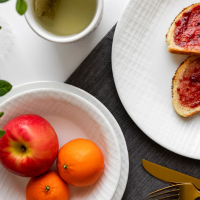Spring is a gorgeous time of year in Australia. The flowers bud, the bees buzz and finally after a long winter the days become warm, getting longer and longer in the countdown to Summer.
Spring also marks a distinct culinary shift. We move away from the hearty meals of winter that focussed on root vegetables and slow-cooking, toward the fresh and vibrant produce of Spring. It’s all about colour, citrus zing and crisp, crunchy textures. We think Spring 2016 is going to be dominated by curing!
Curing is often thought of as a technique used to preserve foods in harsh climates. Used by remote civilisations to keep food fresh for times of hardship, but it is so much more than that!
Restaurants have been curing stuff for years, with chefs realising that, if done correctly, it’s a great way to highlight fresh produce, especially seafood. It’s such a versatile technique and really simple as well, so it’s perfect for Spring afternoon canapés!
What is curing?
Essentially, curing means to preserve food traditionally by way of salting (or sugaring), drying, smoking or application of nitrates/nitrites. Curing draws out moisture by a process of osmosis, elongating the shelf life of the food. Familiar with jerky?
What can be cured?
Virtually anything can be cured, but often the most common foods are meat and seafood.
How long should I cure for?
The length of cures varies drastically based on what is being cured and the desired outcome. For Spring, It’s all about the ‘quick cure’ to retain freshness. Anything up to around 24 hours is appropriate.
The idea behind quick curing is not so much to preserve the food but to impart a unique flavour profile.
One of my all time favourite things to cure is trout. Here’s a delicious recipe to get you started.
Gin and Orange Cured Ocean Trout
Gin is a great curing agent for all types of oily fish. The alcohol in the gin provides a preservative effect, with all the richness and subtlety of the botanicals leaving a lasting impact on the final product. For example, you could try this recipe with Salmon or Kingfish if you’d prefer.
Whilst you can use your standard London Drys, australian gins often have complex citrus flavour profiles utilising native botanicals, and these make for the perfect match for fish. The orange peel provides a real warmth and beautiful fragrance. It’s really easy and simple to create.
This cured trout can be used in a heap of different ways. Incorporate it into a salad with fennel and orange segments or atop pumpernickel rounds with a herbed crème fraiche as a beautiful canapé for entertaining.
Ingredients:
- 100g Caster Sugar
- 100g Sea Salt Flakes
- 100ml Small Batch Australian Gin (Tip: pick one with a citrus profile)
- Grated Zest of 2 oranges
- 1 side of ocean trout (Around 1kg)
Step 1
- Combine the salt, sugar, gin and orange zest in a bowl and stir to combine.
- Place a piece of plastic wrap 1.5 times the length of the trout fillet on a workbench and scatter a little of your curing mixture over plastic. Lay trout on top, pat remaining mixture onto flesh. Wrap tightly. Alternatively, if you have a cryovac machine, you can use this.
Step 2
- Refrigerate, turning once or twice until lightly cured. Curing time will depend on the thickness of the fillet, but around 8-10 hours (or overnight).
Step 3
- Wipe off salt mixture and liquid with absorbent paper and it is ready to serve. Use a razor-sharp knife to finely slice on the diagonal.
Have you tried curing your own meat before? Share your experience below!
Image source Shutterstock.






















-

-
-
meedee said
- 08 Dec 2021
-

-
-
mom81879 said
- 30 Nov 2019
-

-
-
youngoldlady said
- 28 Oct 2018
-

-
-
ella12 said
- 21 Feb 2017
-

-
-
mom81879 said
- 10 Jan 2017
-

-
-
mom101628 said
- 14 Nov 2016
-

-
-
mom70876 said
- 14 Nov 2016
-

-
-
tessie said
- 10 Nov 2016
-

-
-
rovermum said
- 31 Oct 2016
-

-
-
mom134803 said
- 28 Oct 2016


-

-
-
mom101628 said
- 27 Oct 2016
-

-
-
mom134803 said
- 10 Oct 2016


-

-
-
Nas01 said
- 09 Oct 2016
-

-
-
june11 said
- 06 Oct 2016
-

-
-
mom93821 said
- 18 Sep 2016
-

-
-
mom90758 said
- 16 Sep 2016
-

-
-
mom112217 said
- 16 Sep 2016
Post a comment1:07 pm
9:08 am
9:31 pm
4:20 pm
1:30 pm
11:52 pm
11:07 pm
1:20 am
8:59 am
3:24 am
11:31 pm
7:41 am
3:45 pm
10:18 pm
11:51 am
7:06 pm
-

-
-
mom93821 replied
- 19 Sep 2016 , 6:06 am
Reply10:17 am
To post a review/comment please join us or login so we can allocate your points.